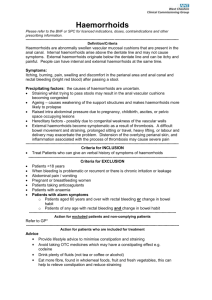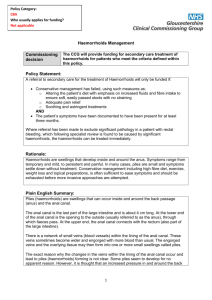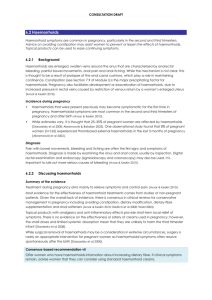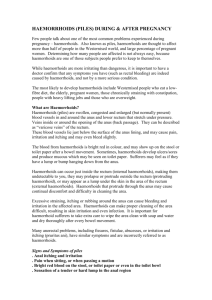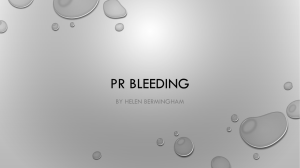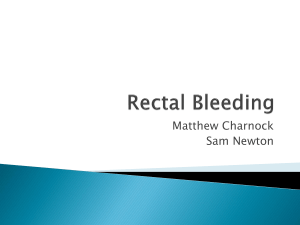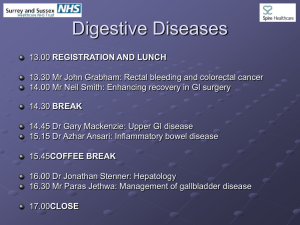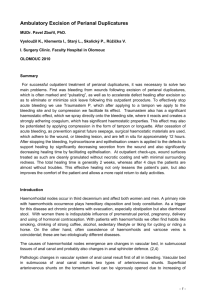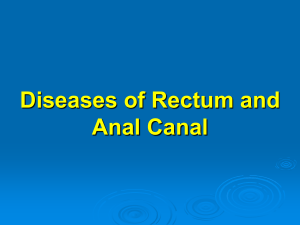Haemorrhoids
advertisement
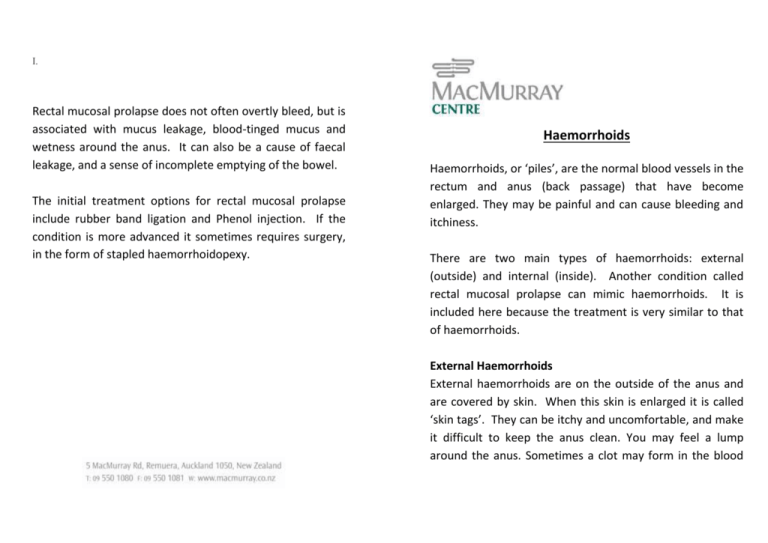
I. Rectal mucosal prolapse does not often overtly bleed, but is associated with mucus leakage, blood-tinged mucus and wetness around the anus. It can also be a cause of faecal leakage, and a sense of incomplete emptying of the bowel. The initial treatment options for rectal mucosal prolapse include rubber band ligation and Phenol injection. If the condition is more advanced it sometimes requires surgery, in the form of stapled haemorrhoidopexy. Haemorrhoids Haemorrhoids, or ‘piles’, are the normal blood vessels in the rectum and anus (back passage) that have become enlarged. They may be painful and can cause bleeding and itchiness. There are two main types of haemorrhoids: external (outside) and internal (inside). Another condition called rectal mucosal prolapse can mimic haemorrhoids. It is included here because the treatment is very similar to that of haemorrhoids. External Haemorrhoids External haemorrhoids are on the outside of the anus and are covered by skin. When this skin is enlarged it is called ‘skin tags’. They can be itchy and uncomfortable, and make it difficult to keep the anus clean. You may feel a lump around the anus. Sometimes a clot may form in the blood vessel under the skin tag and cause a lot of pain. This is called a thrombosed external haemorrhoid. Internal Haemorrhoids Internal haemorrhoids are inside the back passage in the area where the rectum joins the anus and are covered by the mucous lining of the rectum. They are enlargements of the normal cushions of blood vessels that help to keep the sphincter of your anus tightly closed. Internal haemorrhoids are not usually painful. Often the first sign you will notice is bleeding when you have had a bowel motion. Sometimes internal haemorrhoids may come down (prolapse) through the back passage. You may feel a lump coming down when you have a bowel motion and notice painless bleeding. Prolapsed haemorrhoids often produce mucus and may leave your underclothes stained. Internal haemorrhoids can be very painful when they completely prolapse and cannot be pushed back inside. Causes of Haemorrhoids An exact cause is often unknown. Contributing factors include: Surgery may be done as day surgery or an overnight stay in hospital may be required. The surgeon will help decide the best option for you. After surgery there is usually bleeding from the anus for a few days and you may need to wear a pad for a week because of discharge from the healing wound. You will need to take a laxative and a bulking agent to soften your bowel motions for a few days. When you have had a bowel motion a warm salt bath helps to reduce pain and spasm of the anal area. You should be able to return to normal activities within one to two weeks following surgery. Rectal mucosal prolapse In this condition, the rectal lining (mucosa) above the region of the haemorrhoids slides downwards into the anal canal, and can even appear at the anus, similar to a prolapsing haemorrhoid. Sometimes this condition is an indication that a more significant, full rectal prolapse is occurring. This is usually evident on careful clinical examination, but may sometimes require an X-ray study of the bowel emptying (defecating proctogram) to clarify the situation. haemorrhoids that keep bleeding; and haemorrhoids associated with troublesome skin tags. The haemorrhoid and its overlying skin are removed and either left open to heal or stitched closed with dissolving stitches. This surgery can cause postoperative pain for two to four weeks, which is managed with pain-relieving medication. You should be able to return to normal activities in two to three weeks. Avoid heavy lifting during this time. Stapled Haemorrhoidopexy This is useful for prolapsing internal haemorrhoids and large external haemorrhoids. A disposable circular stapler is inserted through the anus into the rectum. The stapler time joins the remaining circle of tissue together with a ring of titanium staples. This procedure is generally less painful than the standard haemorrhoidectomy as the tissue removed is in the rectum and has fewer pain receptors. Ageing Chronic constipation or diarrhoea Pregnancy and childbirth Heredity Straining during bowel movements Spending long periods of time (e.g. reading) on the toilet Obesity Lifting heavy weights incorrectly Treatment of Haemorrhoids Your doctor will discuss with you the best treatment for your haemorrhoids after examining you. Some simple lifestyle changes may be needed to help prevent them getting worse. These include: A high fibre diet that includes vegetables, fruit, grains and cereals. Drinking plenty of fluids - at least a litre a day is recommended. The aim is to prevent constipation and straining which can contribute to haemorrhoids. Your GP may have already prescribed some laxatives to soften your bowel motions, and make you more regular. Some topical preparations such as suppositories and ointments are also useful to control the symptoms of an acute flare-up. If the haemorrhoids require definitive treatment, this can be done with a variety of methods. These aim to shrink, destroy or remove the haemorrhoids. Rubber Band Ligation (‘Banding’) This treatment is used on larger internal haemorrhoids that protrude with bowel motions. This procedure is done in the clinic. It involves putting a tiny rubber band over the haemorrhoid, cutting off its blood supply and causing it to fall off in a few days. Generally you will not notice that you have passed the rubber band/haemorrhoid into the toilet. The inside wound usually heals up within one to two weeks. The procedure may cause some minor bleeding. It is also associated with a dull anal ache which is usually managed with Paracetamol. It can also cause a sensation of rectal fullness, which will make you feel like having a bowel motion. It is important to ignore this sensation as much as possible; repeated attempts to pass the banded haemorrhoids can make them swell further. It is better to visit the lavatory your usual number of times per day, and try to otherwise avoid prolonged attempts to pass something. The sensation will last 3-4 days. Phenol injection This is used for small internal haemorrhoids and causes them to shrivel up over the course of a few weeks. It is less frequently performed than ‘banding’ but does have equivalent results. The injection is done at a clinic visit. It is a quick and relatively painless procedure. The injection is placed into the haemorrhoid itself, and therefore minor bleeding for 48 hrs after the procedure is very common. Following this procedure there are no special instructions regarding toileting, other avoiding straining on the lavatory. Surgery Haemorrhoidectomy This is the surgical removal of haemorrhoids and is required for haemorrhoids that form clots inside them; prolapsing
